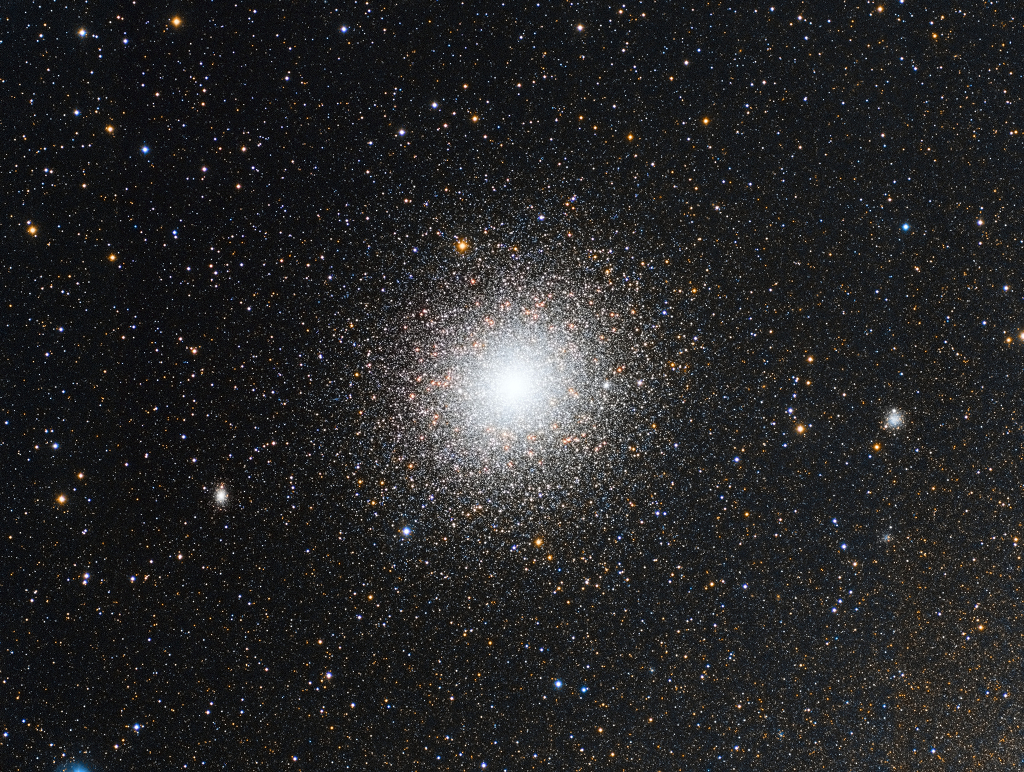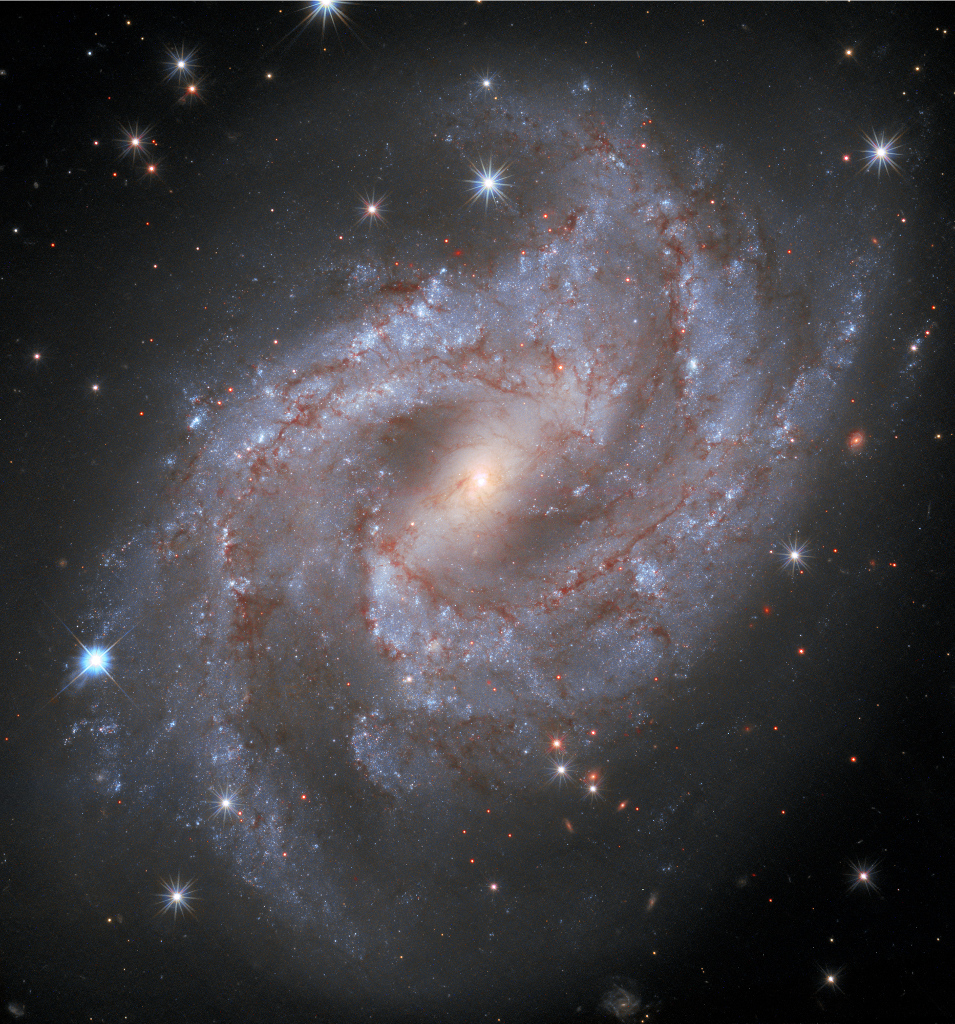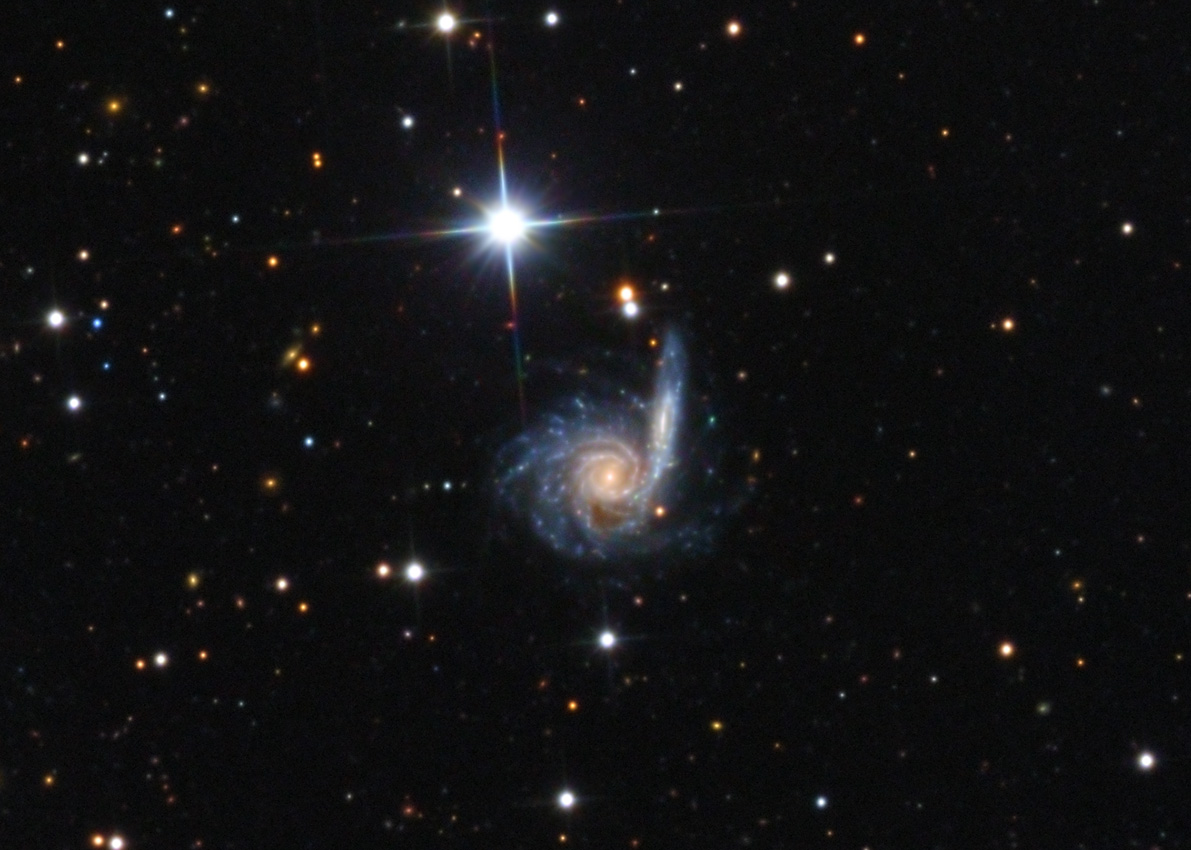Globular star cluster 47 Tucanae is a jewel of the southern sky. Also known as NGC 104, it roams the halo of our Milky Way Galaxy along with some 200 other globular star clusters. The second brightest globular cluster (after Omega Centauri) as seen from planet Earth, it lies about 13,000 light-years away and can be spotted naked-eye close on the sky to the Small Magellanic Cloud in the constellation of the Toucan. The dense cluster is made up of hundreds of thousands of stars in a volume only about 120 light-years across. Red giant stars on the outskirts of the cluster are easy to pick out as yellowish stars in this sharp telescopic portrait. Tightly packed globular cluster 47 Tuc is also home to a star with the closest known orbit around a black hole.

Bill Wyman (born William George Perks; 24 October 1936) is an English musician, record producer, songwriter and singer. He was the bassist for the English rock and roll band the Rolling Stones from 1962 until 1993. Since 1997 he has recorded and toured with his own band, Bill Wyman’s Rhythm Kings. He has worked producing records and films, and has scored music for films and television.
Wyman has kept a journal since he was a child after World War II. He has published seven books. Wyman is also a photographer, and his works have been displayed in galleries around the world. He became an amateur archaeologist and enjoys metal detecting. He designed and marketed a patented “Bill Wyman signature metal detector“, which he has used to find relics in the English countryside dating back to the era of the Roman Empire.
see full post...Odean Pope (born October 24, 1938) is an American jazz tenor saxophonist.
Pope was raised in Philadelphia, where he learned from Ray Bryant while young. Early in his career, at Philadelphia’s Uptown Theater, Pope played behind a number of noted rhythm and blues artists including James Brown, Marvin Gaye and Stevie Wonder.
He played briefly in the 1960s with Jimmy McGriff, and late in the 1960s he began working with Max Roach, including on tours of Europe in 1967-68. He was a member of Philadelphia group Catalyst in the early and mid-1970s, and assembled the Saxophone Choir, which consists of nine saxophones and a rhythm section (piano, bass and drums), in 1977. He became a regular member of Roach’s quartet in 1979 and recorded extensively with him, in addition to numerous releases as a leader.
see full post...Willie James Mabon (October 24, 1925 – April 19, 1985) was an American R&B singer, songwriter and pianist, who had two number one hits on the Billboard R&B chart: “I Don’t Know” in 1952 and “I’m Mad” in 1953.
Mabon was born and brought up in the Hollywood district of Memphis, Tennessee. He moved to Chicago in 1942, by which time he had become known as a singer and pianist. He formed a group, the Blues Rockers, and in 1949 began recording for Aristocrat Records and then Chess Records.
His biggest success came in 1952 when his debut solo release, “I Don’t Know“, written by Cripple Clarence Lofton (who received no royalties),[4]topped the Billboard R&B chart for eight weeks. It was one of the most popular releases of its era and was Chess’s biggest hit before the successes of Chuck Berry and Bo Diddley. It was also one of the first R&B hit records to be covered by a leading white artist, Tennessee Ernie Ford. Mabon’s original was played on Alan Freed‘s early radio shows and also sold well to white audiences, crossing over markets at the start of the rock-and-roll era.
see full post...Saunders Teddell, or Saunders Terrell (or other variants, sources differ) (October 24, 1911 – March 11, 1986), known as Sonny Terry, was an American Piedmont blues and folk musician,who was known for his energetic blues harmonica style, which frequently included vocal whoops and hollers and occasionally imitations of trains and fox hunts.
Terry was born in Greensboro, Georgia. His father, a farmer, taught him to play basic blues harp as a youth. He sustained injuries to his eyes and went blind by the time he was 16, which prevented him from doing farm work, and was forced to play music in order to earn a living. Terry played Campdown Races to the plow horses which improved the efficiency of farming in the area. He began playing blues in Shelby, North Carolina. After his father died, he began playing in the trio of Piedmont blues–style guitarist Blind Boy Fuller. When Fuller died in 1941, Terry established a long-standing musical relationship with Brownie McGhee, and they recorded numerous songs together. The duo became well known among white audiences during the folk music revival of the 1950s and 1960s. This included collaborations with Styve Homnick, Woody Guthrie and Moses Asch, producing classic recordings for Folkways Records (now Smithsonian/Folkways).
https://www.youtube.com/watch?v=DsMW8t-8cVU
see full post...
https://www.youtube.com/watch?v=3Z3L0hNtl_E
see full post...Barred spiral galaxy NGC 2525 lies 70 million light-years from the Milky Way. It shines in Earth’s night sky within the boundaries of the southern constellation Puppis. About 60,000 light-years across, its spiral arms lined with dark dust clouds, massive blue stars, and pinkish starforming regions wind through this gorgeous Hubble Space Telescope snapshot. Spotted on the outskirts of NGC 2525 in January 2018, supernova SN 2018gv is the brightest star in the frame at the lower left. In time-lapse, a year long series of Hubble observations followed the stellar explosion, the nuclear detonation of a white dwarf star triggered by accreting material from a companion star, as it slowly faded from view. Identified as a Type Ia supernova, its brightness is considered a cosmic standard candle. Type Ia supernovae are used to measure distances to galaxies and determine the expansion rate of the Universe.

Ernest James Watts (born October 23, 1945) is an American jazz and rhythm and blues saxophonist who plays soprano, alto, and tenor saxophone. He has worked with Charlie Haden’s Quartet West and toured with the Rolling Stones. On Frank Zappa’s album The Grand Wazoo he played the “Mystery Horn”, a straight-necked C melody saxophone. He played the notable saxophone riff on The One You Love by Glenn Frey.
Watts was born in Norfolk, Virginia, and began playing saxophone at thirteen. After a brief period at West Chester University, he attended the Berklee College of Music on a Down Beat magazine scholarship. He toured with Buddy Rich in the late-1960s, occupying one of the alto saxophone chairs. He visited Africa on a U.S. State Department tour with Oliver Nelson‘s group. For twenty years he played alto saxophone with The Tonight Show Bandunder Doc Severinsen. He was a featured soloist on many of Marvin Gaye‘s albums on Motown during the 1970s, as well as on many other pop and R&B sessions during his twenty-five years as a studio musician in Los Angeles. He has won two Grammy Awards as an instrumentalist. In the mid-1980s Watts decided to rededicate himself to jazz. He recorded and toured with German guitarist and composer Torsten de Winkel, drummer Steve Smith, and keyboardist Tom Coster. He was invited to join Charlie Haden‘s Quartet West. They met backstage one night after Haden heard Watts play “Nightbird” by Michel Colombier. Watts played on soundtracks for the movies Grease and The Color Purple and on the theme song for the TV show Night Court.
see full post...Frank Hewitt (October 23, 1935 – September 5, 2002) was an American hard bop jazz pianist.
Born in Queens, New York, Hewitt lived most of his life in Harlem. His mother was a church pianist, and he initially studied classical and gospel music, but switched to jazz after hearing a Charlie Parker record. He took the bop pianists Thelonious Monk, Bud Powell and Elmo Hope as his role models. In the 1950s and 1960s he worked with Howard McGhee, Cecil Payne, John Coltrane, Dinah Washington and Billie Holiday, among others; in 1961 he also participated in the Living Theater‘s production of Jack Gelber‘s The Connection. He became a regular figure in the circle of the pianist Barry Harris. In the 1990s Hewitt became a central figure at New York’s Smalls Jazz Club; aside from playing there several nights a week, he sometimes also ended up using the walk-in refrigerator as a place to bunk when times were rough.
During his lifetime only one track of Hewitt’s playing was released, a version of the Kenny Dorham tune “Prince Albert” on the compilation Jazz Underground: Live at Smalls (Impulse, 1998). After Hewitt’s death, however, recordings made by Luke Kaven began to surface on Kaven’s Smalls Records label: the trio discs We Loved You, Not Afraid to Live, Fresh from the Cooler, and Out of the Clear Black Sky, and the quintet date Four Hundred Saturdays. His reputation as a neglected jazz master has steadily grown among fans of bebop piano.
see full post...William “Sonny” Criss (23 October 1927 – 19 November 1977) was an American jazz musician. An alto saxophonist of prominence during the bebop era of jazz, he was one of many players influenced by Charlie Parker.
William Criss was born in Memphis, Tennessee and moved to Los Angeles at the age of 15. He then went on to play in various bands including Howard McGhee‘s, which also featured Charlie Parker. Criss had developed his own, concise, bluesy tone by this point, and though his basic style did not vary much, his ability on the instrument continued to develop. Nevertheless, he continued to drift from band to band, and played on some records with Johnny Otis and Billy Eckstine. His first major break came in 1947, on a number of jam sessions arranged by jazz impresario Norman Granz. In 1956 he signed to Imperial Records, based in New York, and recorded a series albums including Jazz U.S.A , Go Man! and Sonny Criss Plays Cole Porter featuring pianist Sonny Clark. Capitol, which owned the master recordings, reissued them as a 2-CD set on their Blue Note imprint in 2000. Criss also recorded At the Crossroadswith pianist Wynton Kelly.
Prestige signed Criss in 1965, and he continued to record well-acclaimed albums which were mainly rooted in hard bop traditions. Sonny’s Dreamfeatured arrangements by Horace Tapscott. Later sessions were recorded for Muse and Impulse.
see full post...Rumba flamenca, also known as flamenco rumba or simply rumba (Spanish pronunciation: [ˈrumba]), is a palo (style) of flamenco music developed in Andalusia, Spain. It is known as one of the cantes de ida y vuelta (roundtrip songs), music which diverged in the new world, then returned to Spain in a new form. The genre originated in the 19th century in Andalusia, southern Spain, where Cuban music first reached the country. Rumba flamenca was primarily influenced by guaracha, an uptempo style of vocal music which originated in Havana‘s musical theatre. Some elements from Cuban rumba were also incorporated, although minor, despite the name. Although unlikely, both guaracha and Cuban rumba might have been influenced by flamenco earlier in the 19th century. Guarachas can be traced back to the Spanish jácaras, thus justifying the classification of rumba flamenca as a cante de ida y vuelta.
see full post...NGC 6365 is about 385 million light years away, with a separation of 20 million light years between the individual galaxies if their peculiar velocities are of no consequence. However, for objects at such distances we should take into account the expansion of the Universe during the time it took their light to reach us. Doing that shows that the galaxies were about 375 million light years away at the time the light by which we see them was emitted, about 380 million years ago (the difference between the two numbers being due to the expansion of the intervening space during the light-travel time). Given that and its apparent size of 1.15 by 0.85 arcmin, PGC 60174 is about 120 thousand light years across, while PGC 60171’s apparent size of 1.1 by 0.2 arcmin corresponds to about 120 to 125 thousand light years (depending upon whether it is closer or further than its apparent companion). Note: The face-on galaxy (PGC 60174) is a Seyfert galaxy.

see full post...
Leslie West (born Leslie Weinstein; October 22, 1945) is an American rock guitarist, vocalist, and songwriter. He is best known as a founding member and co-lead vocalist of the hard rock band Mountain.
West was born in New York City, to a Jewish family. He grew up in Hackensack, New Jersey, and in East Meadow, New York, Forest Hills, New York and Lawrence, New York. After his parents divorced, he changed his surname to West. His musical career began with the Vagrants, an R&B/blue-eyed soul-rock band influenced by the likes of the Rascals that was one of the few teenage garage rock acts to come out of the New York metropolitan area itself (as opposed to the Bohemian Greenwich Village scene of artists, poets and affiliates of the Beat Generation, which produced bands like The Fugs and The Velvet Underground). The Vagrants had two minor hits in the Eastern US: 1966’s “I Can’t Make a Friend” and a cover of Otis Redding‘s “Respect” the following year.
Some of the Vagrants’ recordings were produced by Felix Pappalardi, who was also working with Cream on their album Disraeli Gears. In 1969, West and Pappalardi formed the pioneering hard rock act Mountain, which was also the title of West’s debut solo album. Rolling Stone identified the band as a “louder version of Cream”. With Steve Knight on keyboards and original drummer N. D. Smart, the band appeared on the second day of the Woodstock Festival on Saturday, August 16, 1969 starting an 11-song set at 9 pm.
see full post...Douglas Clare Fischer (October 22, 1928 – January 26, 2012 Durand,MI) was an American keyboardist, composer, arranger, and bandleader. After graduating from Michigan State University (from which, five decades later, he would receive an honorary doctorate), he became the pianist and arranger for the vocal group the Hi-Lo’s in the late 1950s. Fischer went on to work with Donald Byrd and Dizzy Gillespie, and became known for his Latin and bossa nova recordings in the 1960s. He composed the Latin jazz standard “Morning“, and the jazz standard “Pensativa“. Consistently cited by jazz pianist and composer Herbie Hancock as a major influence (“I wouldn’t be me without Clare Fischer”), he was nominated for eleven Grammy Awards during his lifetime, winning for his landmark album, 2+2 (1981), the first of Fischer’s records to incorporate the vocal ensemble writing developed during his Hi-Lo’s days into his already sizable Latin jazz discography; it was also the first recorded installment in Fischer’s three-decade-long collaboration with his son Brent. Fischer was also a posthumous Grammy winner for ¡Ritmo! (2012) and for Music for Strings, Percussion and the Rest (2013).
Beginning in the early 1970s, Brent Fischer embarked on a parallel (and far more lucrative) career, eventually becoming a much sought-after arranger, providing orchestral “sweeteners” for pop and R&B artists such as Rufus (with Chaka Khan), Prince (a regular client from 1984 onwards, and by far Fischer’s most frequent in pop music), Robert Palmer, Paul McCartney, Michael Jackson, Celine Dion, Elvis Costello & The Roots, D’Angelo song Really Love from the album Black Messiah Grammy-winner (2016) for best R&B album, Sheila E, and many others.
see full post...Cándido de Guerra Camero (born April 22, 1921), also known simply as Cándido, is a Cuban conga and bongo player. He also plays the tres, drums, and acoustic bass. He has worked in many genres of popular music from pop, rock, R&B and disco to Afro-Cuban dance music and Latin jazz. He is the first player to develop techniques to play multiple conga drums, coordinated independence and the use of multiple percussion, one player playing a variety of percussion instruments simultaneously.
Early in his career, Camero recorded in his native Cuba with many of the early pioneers of the son movement as well as being the conga drummer for the Tropicana night club in Havana from its opening night in 1940 and subsequently for the next eight years. He first appeared in NYC in the musical review, Tidbits, at the Plymouth Theater on Broadway in 1946 backing up the Cuban dance team of Carmen and Rolando. In 1948 he made his first U.S. recording with Machito and His Afro-Cubans on the tune, “El Rey Del Mambo.” as well as working with Dizzy Gillespie. During 1953–54, he was in the Billy Taylor Trio and in 1954 he performed and recorded with Stan Kenton.
see full post...